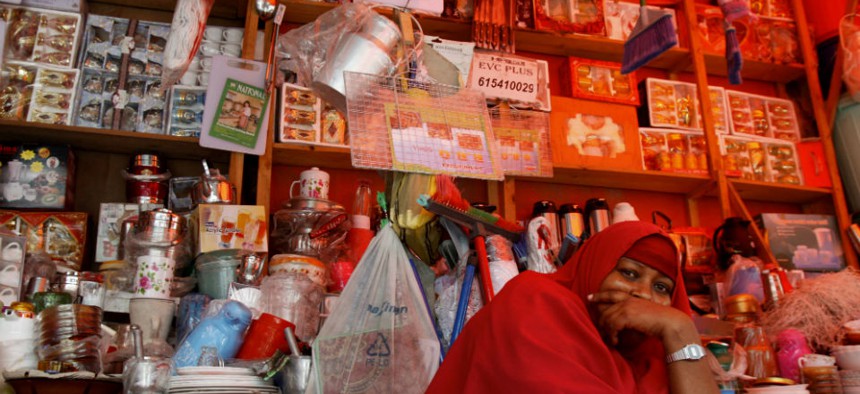What Somalia’s New Internet Looks Like From Silicon Valley

A Somali shopkeeper sells kitchen utensils sits in her shop in Mogadishu, Somalia. Farah Abdi Warsameh/AP
Internet providers rolled out fiber optic connections in nation’s capitol, Mogadishu.
Somalia’s first terrestrial fiber optic cables have connected the country to the modern internet. The BBC reported that Somalis have been in “culture shock” ever since. “They’re very excited about the speed,” a spokesman from Somalia Wireless, an internet service provider (ISP), told the BBC, which reports that:
People have been flocking to hotels and internet cafes to try out the fast service – some seeing video platforms like YouTube and social networking sites for the first time, our correspondent says.
Until recently, internet connectivity in Somalia came exclusively through dial-up modems and satellite. Then, in the last couple of weeks, internet providers rolled out fiber optic connections in nation’s capitol, Mogadishu. The cables run though Somalia’s neighbor, Kenya, which hooked up the first of four undersea cables in 2009.
What does this cataclysmic cultural shift in Somalia look like to the rest of the world? In the gigantic, rushing river of the internet, it turns out that a new country coming online is a trickle that barely registers.
What happens when a country of 10 million joins the world
Somalia, battered by civil war, divided into breakaway states, and subject to an internet ban by the Al-Shabab , could certainly do with a way to reliably connect with the outside world. The difference such connectivity can make to its people isn’t just a feel-good story peddled by the Western press. In Kenya, high-speed internet had a transformative effect: prices for internet connections plummeted, speeds increased, and Kenya started developing a tech and start-up industry of its own . It is now the East Africa headquarters of several big firms , and is producing homegrown tech products for the outside world.
But viewed from afar in terms of internet use, Somalia’s recent connections seem to have had little immediate impact. A look at the traffic flowing from Somalia via Akamai, an internet infrastructure firm that delivers between 15% and a third of the world’s internet traffic, shows that not much has changed in the last few weeks:

Akamai declined to disclose specific numbers (hence the blank y-axis on the chart above).
Another proxy for looking at whether people are using the internet more is through DNS requests. The web is made of human-readable addresses, such as qz.com. But for machines to understand where to direct you, they need to translate that to a computer-readable numerical address through the “domain name system.” This is generally done by internet service providers, but individuals and ISPs alike often use a third-party service such as Google or OpenDNS. Here’s what OpenDNS saw from Somalia over the past six months:

Again, there’s not much difference over the past week or two and no recent spikes. So is the BBC’s man in Mogadishu chewing too much khat?
Probably not. With a country making its first tentative steps online, anecdotal evidence can sometimes paint a truer picture than big data. As the BBC points out, fiber optic connections are up and running only in Mogadishu, home to about 13% of Somalia’s population. Moreover, Somalia’s contribution to the world’s internet traffic is minuscule, so it takes some close examination of worldwide data to build a picture of its habits.
At Quartz’s request, Martin Levy from Cloudflare, another big back-end service provider, examined his company’s numbers. Somalia accounts for only 0.0003% of Cloudflare’s traffic, Levy said. But, he added:
We just looked at the graphs for Somalia traffic and while the transfer levels are very low (and hence there’s a lot of noise on the graphs) there looks like a definite up-tick over the last week… It took a lot of squinting by a few engineers to accept the fact that it’s showing improvement week-over-week.
The last week may have felt like a sea-change in Mogadishu, but it isn’t just the new fiber optic cables that have made a difference in Somalis’ internet experience. According to Akamai’s Belson, “Over the last year, our peak traffic levels for content delivered into Somalia were up 2.14x, while our average traffic levels for content delivered into Somalia were up 2.86x…Looking at some neighboring countries, as well as the US, for comparison, it appears that these growth rates are higher than these other countries.”

As more internet providers join up to the new, faster connections, that growth will only accelerate. And with decent connectivity, perhaps Somalia, like Kenya, will soon be able to sprout new businesses to enrich its population.
Reprinted with permission from Quartz . The original story can be found here .





